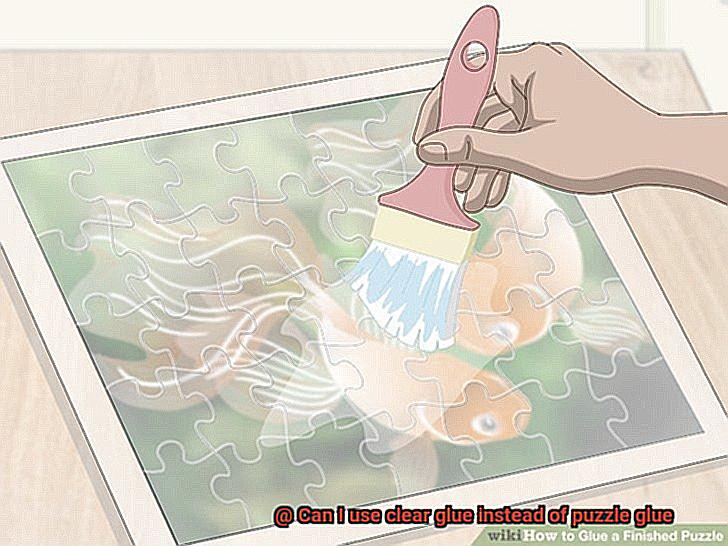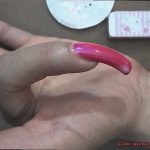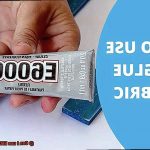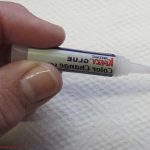Are you one of those dedicated puzzlers who revel in the challenge of completing intricate jigsaw masterpieces? If so, you know that once the final piece is in place, there’s still one hurdle left to conquer – the puzzle gluing process. And here’s where the great debate begins: can everyday clear glue be a suitable substitute for specialized puzzle glue?
In this blog post, we’re going to delve into the nitty-gritty of using clear glue instead of puzzle glue and explore both sides of the argument. Sure, clear glue might seem like a tempting choice with its lower price tag and easy availability, but before you make your decision, it’s crucial to understand all the potential consequences.
So, if you’re torn between reaching for that trusty bottle of clear glue from your craft drawer or investing in proper puzzle glue, keep reading. We’ll uncover all the pros and cons of each option so that you can make an informed and puzzle-perfecting choice.
What is Clear Glue?
Contents
It will delve into the key characteristics of clear glue, its various forms, and its diverse range of applications.
Key Characteristics:
- Transparent Finish: Clear glue is prized for its ability to dry completely transparent, ensuring that the adhesive remains invisible on projects. Its seamless finish preserves the original appearance of crafts without any unsightly marks or discoloration.
- Water-Based Formula: Made from a water-based formula, clear glue is non-toxic and safe to use. This makes it an excellent option for both children and adults, providing peace of mind while working on creative endeavors.
Forms of Clear Glue:
- Liquid Clear Glue: The most common form of clear glue, it comes in bottles with a convenient nozzle for easy application. Ideal for general crafting projects such as paper crafts, cardmaking, and collages.
- Gel Clear Glue: With a thicker consistency than liquid glue, gel clear glue is perfect for precise bonding or vertical surfaces. Its gel-like texture allows for more control and prevents the adhesive from dripping or running.
- Glue Sticks: Clear glue sticks are solid adhesives that can be conveniently applied by twisting them up and down. They are often used in schools or offices for paper-based projects due to their ease of use.
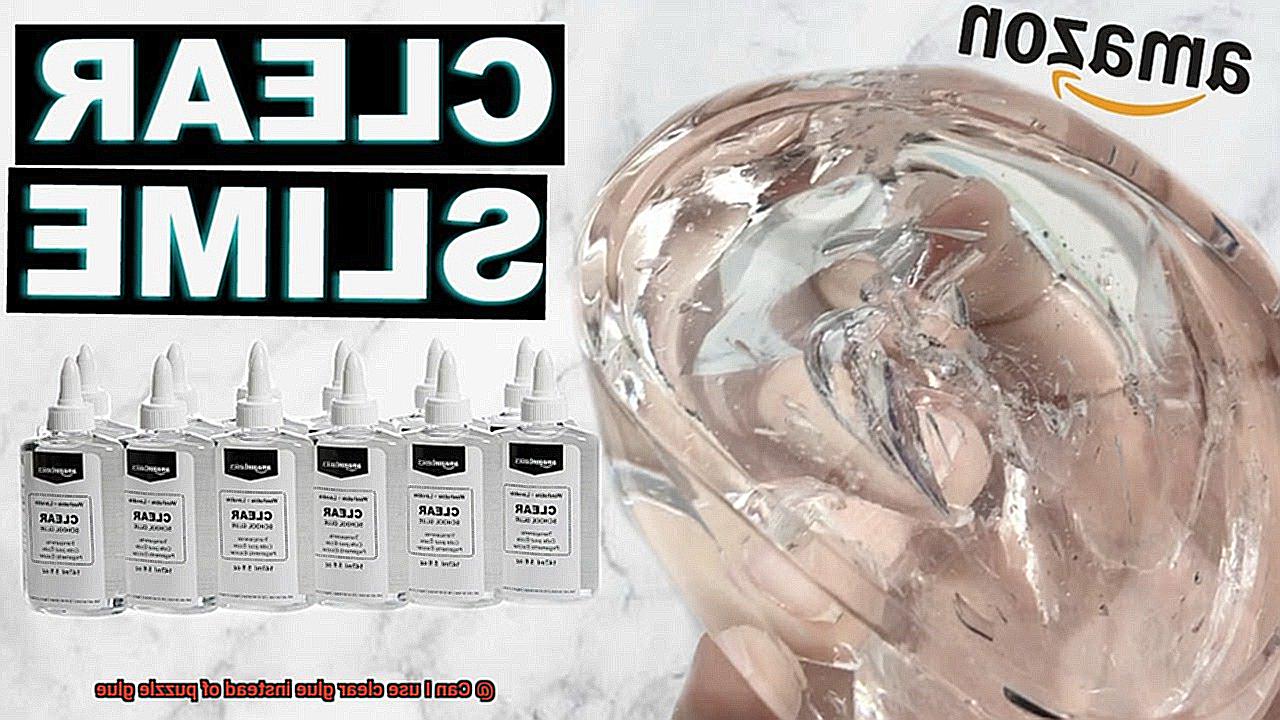
Applications:
- Paper Crafts: Clear glue is commonly used in paper crafts like scrapbooking, cardmaking, and origami. Its transparency ensures that the adhesive does not disrupt delicate paper designs.
- Collages: Perfect for creating collages, clear glue allows you to securely bond different materials while preserving their appearance. Its strong adhesion properties keep your collage pieces firmly in place.
- DIY Projects: Clear glue is a versatile tool for various DIY projects, including repairing broken items, sticking decorations onto surfaces, and even creating homemade slime. Its ease of use and wide range of applications make it a go-to adhesive for many DIY enthusiasts.
What is Puzzle Glue?
Then, puzzle glue is the miraculous solution to all your problems.
Puzzle glue is not your ordinary adhesive; it is a specialized formula meticulously crafted to preserve and protect completed jigsaw puzzles. Unlike regular glue, puzzle glue is designed to adhere seamlessly to the surface of puzzle pieces without causing any damage or warping. With puzzle glue, you can rest assured that once applied, your completed puzzle will stay intact even when subjected to movement or handling.
One of the most remarkable features of puzzle glue is its ability to dry clear. Imagine applying the adhesive to the surface of your completed puzzle and watching it slowly vanish before your eyes, leaving behind nothing but pure transparency.
This magical transformation ensures that the artwork and vibrant colors of your puzzle remain fully visible and unaltered. As a devoted puzzle enthusiast, you spend countless hours assembling intricate designs, and preserving the beauty of your hard work is paramount.
But that’s not all – puzzle glue offers more than just visual delight. It also acts as a protective shield, guarding your artwork against the relentless assault of dust, moisture, and other potential damage. Like a guardian angel, it envelops your masterpiece, sealing it with care and ensuring its longevity for years to come. Puzzle glue strengthens the structural integrity of your puzzle, making it less susceptible to accidental damage or disintegration over time.
And fear not, for using puzzle glue is as simple as piecing together a jigsaw. Most puzzle glues come equipped with an applicator brush or sponge, allowing you to effortlessly spread an even layer of adhesive across the entire surface of your creation. The water-based nature of most puzzle glues means that any spills or excess application can be easily rectified with a touch of soap and water.
Advantages of Using Puzzle Glue
Let me introduce you to your new best friend: puzzle glue. Puzzle glue is not your average adhesive; it’s designed specifically for puzzles, offering a range of advantages that clear glue simply can’t match. If you’re curious about why puzzle glue is the superior choice, keep reading.
First and foremost, puzzle glue is the ultimate protector of your completed masterpiece. It’s formulated to securely adhere the puzzle pieces together, creating a solid and durable finish. Say goodbye to worrying about pieces coming loose or your puzzle becoming damaged over time. Clear glue just can’t provide the same level of adhesion and protection.
Applying puzzle glue is a breeze. Most brands offer a convenient brush applicator, allowing for even distribution across the entire surface of the puzzle. No more uneven coats that clear glue can sometimes leave behind. Puzzle glue ensures that every piece is secured in place, preserving your puzzle for years to come.
One of the best things about puzzle glue is its quick drying time. Many brands boast drying times of one to two hours, meaning you can frame or display your puzzle without having to wait forever. Clear glue may take longer to dry, which can be frustrating if you’re eager to showcase your masterpiece. With puzzle glue, you won’t have to wait long to exhibit your completed work of art.
Speaking of showcasing, puzzle glue dries to a clear and transparent finish, maintaining the vibrant colors and intricate details of your completed puzzle. The clear coating provides a glossy appearance that enhances the overall aesthetic appeal of the artwork. Clear glue just can’t compete when it comes to achieving that professional-looking finish that makes your puzzle truly stand out.
But wait, there’s more. Puzzle glue not only holds the pieces together but also acts as a protective sealant. It helps prevent dust, moisture, and other potential damage from affecting your puzzle. A properly sealed puzzle can maintain its integrity for years to come when preserved with puzzle glue. Clear glue, unfortunately, doesn’t offer the same level of protection. With puzzle glue, you can rest assured that your beloved masterpiece is safeguarded.
And finally, puzzle glue allows you to easily frame and display your completed puzzle. The secure adhesion provided by puzzle glue ensures that the puzzle remains intact, even when mounted vertically. This means you can proudly showcase your puzzle as a work of art, adding a decorative touch to your home or office. Clear glue just can’t provide the same level of stability when it comes to framing and display options.
Disadvantages of Using Clear Glue for Puzzles
Puzzles are more than just a way to pass the time; they are a work of art that challenges our minds and deserves to be preserved. However, when it comes to choosing an adhesive, clear glue may not be the best option. In this article, we will explore the disadvantages of using clear glue for puzzles and highlight why puzzle glue is the superior choice.
Lack of Visibility:
Clear glue’s transparency poses a significant challenge when it comes to ensuring complete coverage on your puzzle. Without being able to see where the adhesive has been applied, there is a risk of not securing all the pieces properly. This can lead to potential damage or even loss of pieces over time. Puzzle glue, with its visible application, ensures every piece is adequately coated for maximum security.
Weak Adhesion:
Unlike puzzle glue, clear glue is not designed explicitly for puzzles, resulting in weaker adhesion. This means that pieces can become loose or fall off entirely, especially when handled or framed regularly. Puzzle glue, however, creates a strong and durable bond between the pieces and backing board, guaranteeing their permanence.
Potential Damage to Puzzle Pieces:
Clear glue often contains stronger chemicals or adhesives that can cause discoloration or warping of puzzle pieces over time. In contrast, puzzle glue is typically water-based and non-toxic, minimizing the risk of damage to the puzzle pieces themselves.
Uneven Application:
Achieving consistent coverage across the entire surface of a puzzle can be challenging with clear glue. Puzzle glue provides an applicator brush or sponge for easy and controlled application, ensuring each piece is evenly coated. Clear glue may require a different applicator or technique, making it harder to achieve uniform coverage.
Lengthy Drying Time:
Compared to puzzle glue, clear glue generally takes longer to dry, which can be frustrating when you are eager to handle or display your completed puzzle. Puzzle glue is specifically designed to dry relatively quickly, allowing you to enjoy your masterpiece sooner.
Difficulty in Removing Excess Glue:
If you accidentally apply too much clear glue, removing the excess can be more challenging than with puzzle glue. Puzzle glue allows for easy removal of excess adhesive, either by wiping or peeling it off once it has dried. Clear glue may require additional cleaning or scraping, which is time-consuming and risks damaging the puzzle surface.
Alternative Methods to Preserve Puzzles
While puzzle glue is a popular choice, there are alternative methods available that offer unique advantages. In this article, we will explore these non-glue preservation methods, providing you with the inside scoop on how to preserve your puzzles without compromising their beauty and integrity.
Method 1: Adhesive Sheets or Contact Paper
Forget the mess of glue and opt for the convenience of adhesive sheets or contact paper. These self-adhesive wonders come in various sizes and can be effortlessly applied to the surface of your completed puzzle. Simply slide the sheet under the puzzle, smoothing it out across the entire surface. Voila. You’ve created a protective layer that holds the puzzle pieces together while preserving its flawless appearance.
Method 2: Puzzle Preserver Sheets
Designed specifically for puzzle preservation, these transparent films with adhesive backing are a game-changer. Found in hobby or craft stores, puzzle preserver sheets offer a simple yet effective solution. Apply these sheets to both the front and back of your completed puzzle, ensuring a secure hold on every piece. The transparency of these sheets allows every intricate detail of your puzzle to shine through, captivating viewers with its awe-inspiring beauty.
Method 3: Clear Acrylic Spray
For those who prefer a hands-off approach, clear acrylic spray is your new best friend. With a fine mist, this spray creates a protective layer that holds the puzzle pieces together with ease. Be sure to follow the manufacturer’s instructions and apply it in a well-ventilated area. Before spraying your entire puzzle, test it on a small corner to ensure it won’t cause any damage or discoloration. With clear acrylic spray, preserving your puzzle becomes as effortless as breathing.
Why Clear Glue Falls Short:
Clear glue may seem tempting, but it falls short when it comes to preserving puzzles. Its lack of adhesive strength may result in loose puzzle pieces over time, potentially ruining your hard work. Additionally, clear glue can dry with a glossy finish, altering the appearance of your puzzle and detracting from its true beauty. To avoid disappointment, stay away from clear glue and instead opt for the methods mentioned above.
Safety Considerations
Ensuring the well-being and protection of researchers, participants, and the environment is crucial for conducting ethical and responsible research. Here are some key safety considerations to keep in mind:
- Personal Protective Equipment (PPE): Researchers must wear appropriate PPE, such as gloves, goggles, lab coats, or respirators, depending on the nature of the research. This helps protect against potential hazards like chemicals, biological agents, or physical risks.
- Hazardous Materials: If the research involves working with hazardous materials, such as chemicals, radioactive substances, or biological samples, it is essential to follow proper handling, storage, and disposal protocols. This includes using fume hoods or safety cabinets, labeling containers correctly, and ensuring proper ventilation.
- Emergency Preparedness: Researchers should be familiar with emergency protocols and know how to respond in case of accidents or incidents. This includes knowing the location of emergency exits, fire extinguishers, and first aid kits.
- Risk Assessment: Before conducting any research activities, it is crucial to assess potential risks and develop mitigation strategies. This involves identifying hazards, evaluating their likelihood and severity, and implementing control measures to minimize risks.
- Ethical Considerations: Safety considerations also extend to ethical aspects of research. Researchers must ensure informed consent is obtained from participants and that their privacy and confidentiality are protected. Additionally, research involving vulnerable populations or sensitive topics requires extra caution to prevent harm or exploitation.
- Data Security: Research data should be stored securely to prevent unauthorized access or loss. This includes using encryption methods for electronic data and implementing appropriate physical security measures for paper documents or samples.
- Fieldwork Safety: If the research involves fieldwork or outdoor activities, researchers must assess potential hazards like extreme weather conditions, wildlife encounters, or terrain risks. They should have appropriate training and equipment to handle these situations safely.
- Equipment Maintenance: Regular maintenance and inspections of research equipment are essential to ensure their safe operation. This includes checking for faulty wiring, calibrating instruments, and replacing worn-out parts.
- Collaboration and Communication: Safety considerations should be communicated effectively among all members of the research team. Clear communication channels and collaboration between researchers, supervisors, and safety officers help identify and address safety concerns promptly.
- Regulatory Compliance: Researchers must adhere to relevant laws, regulations, and institutional guidelines related to safety. This includes obtaining necessary permits or approvals, reporting incidents or accidents, and conducting regular safety audits.
Benefits of Using Puzzle Glue
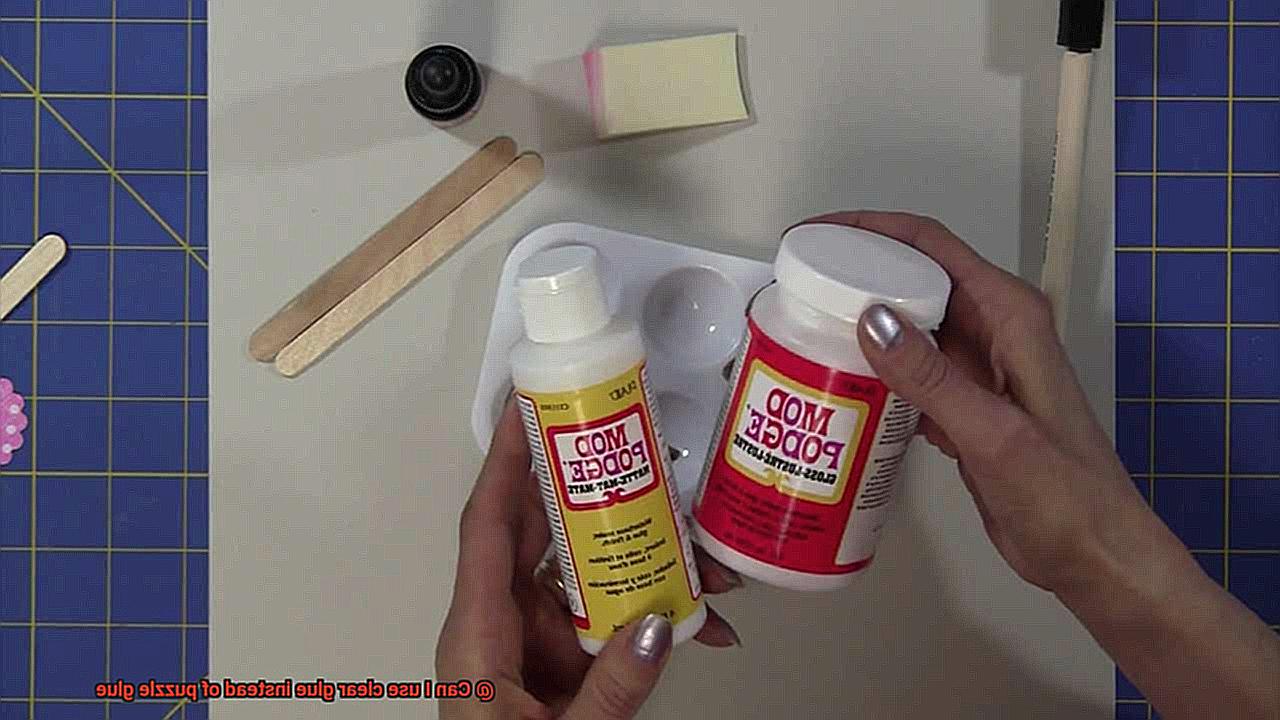
Puzzle glue offers numerous benefits that ensure the longevity, durability, and professional finish of your completed puzzle.
First and foremost, puzzle glue is specifically designed for puzzles and provides a strong adhesive that keeps all the pieces together. Using clear glue instead may result in pieces falling off or becoming loose over time. Puzzle glue guarantees that your completed puzzle remains intact and can be displayed without any worries.
In addition to preserving and protecting the puzzle, puzzle glue enhances its durability. By creating a protective layer over the puzzle surface, it makes the puzzle more resistant to damage. This layer prevents bending or warping, which can occur when using clear glue that lacks similar strength or protective properties. With puzzle glue, you can confidently handle and transport your puzzle without fear of it coming apart.
Furthermore, puzzle glue improves the longevity of your creation. Its adhesive properties keep all the pieces in place, preventing shifting or separating. This ensures that your puzzle will stay intact for years to come, allowing you to enjoy and showcase your hard work.
If you plan on framing your completed puzzle, puzzle glue is essential. It creates a smooth and flat surface, making it easier to mount the puzzle in a frame. Clear glue may not provide the same level of flatness, resulting in an uneven or bumpy surface that challenges proper framing.
Moreover, puzzle glue provides a professional finish. It dries clear and glossy, giving your completed puzzle a polished appearance. This finish enhances the colors and details of the puzzle, making it visually appealing when displayed. Clear glue may lack the same transparent and glossy finish, potentially dulling the vibrancy of the puzzle image.
Applying puzzle glue is also a breeze. It is specifically formulated for easy application with brushes or applicators that allow for smooth and even coverage over the entire puzzle surface. Clear glue may lack the consistency or applicator necessary for even and effective application.
Lastly, some puzzle glues offer a reversible option, allowing you to take apart the puzzle if desired. This can be beneficial if you want to reuse the puzzle or disassemble it for storage. Clear glue does not typically offer this option as it is not specifically designed for puzzles.
RlBvp6hy9TU” >
Conclusion
In conclusion, clear glue may seem like a cheap and convenient alternative to puzzle glue, but it simply doesn’t measure up in several crucial aspects. Puzzle glue is purposefully crafted for puzzles and offers a range of benefits that clear glue cannot replicate.
One of the standout advantages of puzzle glue lies in its exceptional adhesion. It securely holds all the puzzle pieces together, ensuring they remain intact even when handled or framed. Clear glue, on the other hand, runs the risk of loose pieces or even missing ones over time.
Furthermore, puzzle glue acts as a protective sealant for your finished masterpiece. It safeguards against dust, moisture, and other potential damage that could degrade its quality. Clear glue fails to provide the same level of protection.
The finish is another critical factor to consider. Puzzle glue dries with a clear and glossy appearance, enhancing the colors and intricate details of your puzzle while giving it a polished and professional look. Clear glue may dry with an alternate finish that alters the overall appearance.
Moreover, applying puzzle glue is effortless and precise thanks to its specialized applicators. Clear glue may demand different techniques or tools to achieve even coverage.
Last but not least, certain puzzle glues offer a reversible option, allowing you to disassemble or reuse the puzzle if desired—a flexibility not typically found with clear glue.
To summarize, when it comes to preserving your hard work and showcasing your completed puzzles as true works of art, there’s no doubt that puzzle glue reigns supreme. Its steadfast adhesion, protective properties, refined finish, ease of application, and adaptability make it an indispensable tool for any devoted puzzler.

